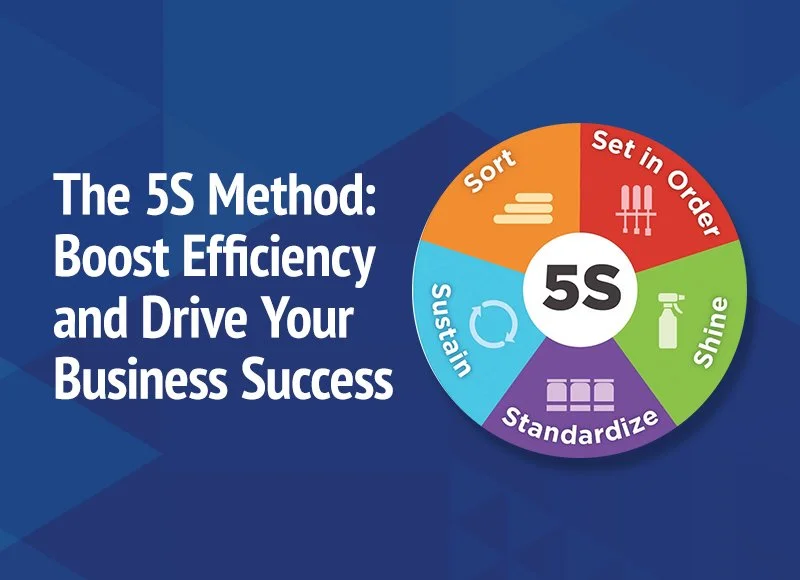Learn The 5S Method: Boost Efficiency and Drive Business Success.
By Casey Gabriel
October 2024
A Japanese Philosophy for Business Success
If you've ever wondered how to improve efficiency and create a more organised workplace, the answer might lie in a simple Japanese approach known as the 5S methodology. Originally developed for manufacturing environments, the 5S framework has proven its value across all industries, offering a straightforward way to improve productivity, morale, and safety. Let's dive into what the 5S system is and how it can transform any business, no matter the size or sector.
What is the 5S method?
The 5S methodology is built on five Japanese principles: Seiri, Seiton, Seiso, Seiketsu, and Shitsuke. In English, these translate to Sort, Set in order, Shine, Standardise, and Sustain. Each of these steps encourages a different aspect of creating an efficient and well-maintained workspace.
Sort (Seiri): The first step is about decluttering. Carefully evaluate all items in the workspace and decide what is necessary and what is not. Only keep what is needed for daily operations and remove anything that doesn’t serve an immediate purpose. This reduces distractions, frees up space, and allows the team to focus on what truly matters. By eliminating clutter, you can create a clearer, more productive environment that helps reduce stress and confusion.
Set in Order (Seiton): Once unnecessary items are removed, it’s time to organise what's left in the most efficient way possible. Designate specific locations for each tool or material, ensuring everything is easy to find and access. Use labels, colour coding, and visual cues to make the organisation intuitive. The goal is to minimise wasted time searching for items, creating a "place for everything, and everything in its place." This not only saves time but also makes it easier for everyone to maintain order.
Shine (Seiso): A clean workspace is a productive one. Shine means more than just tidying up—it involves maintaining cleanliness through regular cleaning routines. Cleanliness enhances the appearance of the workspace, reduces the risk of errors, and ensures that equipment is functioning properly. Regular inspections can help identify potential issues before they become problems, ensuring a safer work environment. A clean workspace can also promote a sense of pride among employees, which can positively impact morale.
Standardise (Seiketsu): Develop standard procedures and guidelines to maintain the organisation and cleanliness achieved in the previous steps. This could involve creating checklists, schedules, or visual reminders to ensure that everyone follows the same procedures consistently. Standardisation helps integrate 5S practices into the company culture, making them second nature to employees. By having clear, documented standards, the organisation can ensure that improvements are maintained over time, reducing the likelihood of reverting to old habits.
Sustain (Shitsuke): The final step is all about discipline and commitment. It involves fostering a culture where following the 5S practices becomes routine. Encourage employees to take ownership of their work areas and hold each other accountable for maintaining standards. Regular training, audits, and reinforcement can help sustain the momentum. The goal is to make 5S a continuous part of the workplace routine, rather than a one-time effort. By embedding these practices into daily habits, businesses can achieve lasting improvements in efficiency and productivity.
How 5S Applies to All Businesses
You might think 5S, how can I really apply this to me? It has enormous potential in any type of business. Whether you're running an office, a retail store, or a small café, the 5S approach helps streamline operations, minimise wasted time, and boost efficiency.
For example:
In an office, applying 5S means decluttering desks, organising digital files, and setting up standardised processes for paperwork. This makes it easier for employees to locate the tools and information they need without losing time.
In a retail environment, 5S can help improve stock management, ensure shelves are neatly arranged, and create a clean, attractive store that appeals to customers. Clear labelling and organised stockrooms make it easier for staff to restock quickly and accurately.
For service-based businesses, the principles of 5S can help structure processes, reduce the chaos that comes with managing multiple clients, and ensure service delivery is consistent and reliable. By organising tools, materials, and information, service providers can focus more on customer needs and less on internal inefficiencies.
The Benefits
Applying the 5S methodology across any industry brings significant advantages, such as reduced operational costs, increased employee satisfaction, and improved quality of work. When everyone knows where things are and what the standards are, it’s easier to work effectively and focus on delivering value to customers.
The 5S system is a mindset—a commitment to continuous improvement. It's not just about cleaning up a workspace; it’s about cultivating a culture where efficiency, organisation, and pride in one's work are part of daily life.
Ready to get started?
Consider starting small. Choose one area of your business and apply the 5S method. Observe how it impacts productivity, and then expand the practice to other areas. With time, you'll likely see not just a tidier workplace, but also a happier, more motivated team.
We can help guide you through the process and assist you in making informed decisions. Call us at (08) 9841 1200 to make a start.
Payday Super Changes: Stay Updated With Proposed Legislation
New Payday Super Regulations on the Horizon for 2026
Attention business owners: Significant changes are coming to how superannuation contributions are processed with the introduction of the new Payday Super regulations, effective from 1 July 2026. These changes will modernise the superannuation system by aligning super payments closely with regular pay cycles. This aims to enhance the transparency and management of super contributions, benefiting employees and employers alike.
Staying ahead of these changes is crucial to ensure compliance and optimise your payroll processes.

